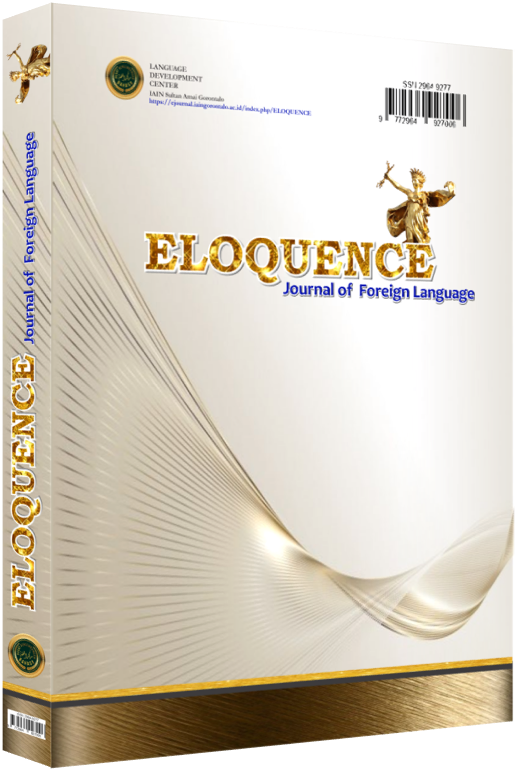The Phenomenon of Arabic Diglossia: A Linguistic Review and its Implications for Foreign Language Teaching
Fenomena Diglosia Arab: Tinjauan Linguistik dan Implikasinya bagi Pengajaran Bahasa Asing
DOI:
https://doi.org/10.58194/eloquence.v4i2.2757Keywords:
Arabic Diglossia, Foreign Language Teaching, Language Learning, Linguistic ImplicationsAbstract
Background: The phenomenon of Arabic diglossia, involving the use of Fusḥā and Ammiyah varieties, remains a challenge in foreign language teaching. The social functions and contexts of these varieties affect the effectiveness of Arabic language learning.
Purpose: This study aims to examine the phenomenon of diglossia in Arabic from a linguistic perspective and explore its implications for teaching Arabic as a foreign language.
Method: The study employs a qualitative approach through literature review in linguistics and language education. The analysis focuses on describing the diglossia phenomenon and strategies for managing it in Arabic language learning.
Results and Discussion: The findings indicate that mastering both language varieties, Fusḥā and „Ammiyah, should be integrated into the curriculum to enable learners to use the language appropriately in social contexts. Learning that accommodates both varieties can enhance communicative competence and enrich the learning experience.
Conclusions and Implications: The diglossia phenomenon requires a balanced approach in teaching Arabic, preserving the formal language while utilizing everyday speech. Practically, this implies developing inclusive and communicative teaching methods to support successful Arabic language learning as a foreign language.
References
[1] C. A. Ferguson, “Diglossia,” Word, vol. 15, no. 2, pp. 325–340, 1959.https://doi.org/10.1080/00437956.1959.11659702
[2] M. Maamouri, Language Education and Human Development: Arabic Diglossia and Its Impact on the Quality of Education in the Arab Region. Philadelphia: UNESCO International Literacy Institute, 1998.
[3] R. Bassiouney, Arabic Sociolinguistics, 2nd ed. Edinburgh: Edinburgh University Press, 2020.https://doi.org/10.1515/9781474457361
[4] A. Albirini, Modern Arabic Sociolinguistics: Diglossia, Variation, Codeswitching, Attitudes and Identity. Routledge, 2016.https://doi.org/10.4324/9781315683737
[5] D. Palfreyman and A. Al-Bataineh, “Diglossia and Arabic language teaching: Investigating teachers’ and students’ beliefs,” Lang. Learn. J., vol. 46, no. 3, pp. 294–304, 2018, doi: 10.1080/09571736.2016.1198095.
[6] K. S. Walters, “A Sociolinguistic Profile of Arabic in the United States,” in Language Contact and Language Conflict in Arabic, A. Rouchdy, Ed., London: Routledge, 1992, pp. 157–174.
[7] B. Anderson, Imagined Communities: Reflections on the Origin and Spread of Nationalism. London: Verso, 2006.
[8] Y. Suleiman, The Arabic Language and National Identity: A Study in Ideology. Edinburgh University Press, 2003.
[9] J. A. Fishman, Language and Nationalism: Two Integrative Essays. Rowley, MA: Newbury House, 1972.
[10] N. Haeri, Sacred Language, Ordinary People: Dilemmas of Culture and Politics in Egypt. Palgrave Macmillan, 2003.https://doi.org/10.1057/9780230107373
[11] M. Al-Batal, “Problems in Teaching the Language and Culture of Arabic,” in The Arabic Language in America: A Documentary History, M. Younes, Ed., Detroit: Wayne State University Press, 1992, pp. 149–174.
[12] M. Younes, Kalima wa Nagham: Integrated Approach to Teaching Arabic. Washington, DC: Georgetown University Press, 2015.
[13] K. C. Ryding, Teaching and Learning Arabic as a Foreign Language: A Guide for Teachers. Georgetown University Press, 2006.
[14] R. Hashem, “A qualitative investigation into the impact of diglossia on the self-learning of an Arabic spoken dialect by Arabic as a foreign language learners,” J. Arts, Lit. Humanit. Soc. Sci., no. 73, pp. 195–209, 2022.
[15] A. H. Putri and A. Thoyyibah, “Exploring Arabic diglossia in learning kalām: Bridging the gap in daily communication,” Alsinatuna J. Arab. Linguist. Educ., vol. 9, no. 2, pp. 175–189, 2024.https://doi.org/10.28918/alsinatuna.v9i2.7076
[16] A. Abdelbary, L. Panascì, and C. Solimando, “Digital Platforms in Teaching Arabic Dialects,” in Technology in Learning, London: IntechOpen, 2023, pp. 1–20.https://doi.org/10.5772/intechopen.110672
[17] M. B. Miles and A. M. Huberman, Qualitative Data Analysis: An Expanded Sourcebook. Thousand Oaks: Sage Publications, 1994.
[18] A. R. Aisyah, Lughatunā wal Hayāt. Mesir: Dar al-Ma‘arif, 1971.
[19] E. B. Ya‘kub, Fiqh al-Lughat al-‘Arabiyah wa Khashāʾiṣuhā. Beirut: Dar al-Tsaqafah al-Islamiyah, 1982.
[20] W. Spitta, Grammar of Colloquial Egyptian Arabic. Leipzig: J.C. Hinrichs, 1880.
[21] J. S. Wilmore, Al-ʿArabiyyah al-Maḥkiyyah fī Miṣr. Cairo: Al-Matbaʿah al-Amīrikiyyah, 1901.
[22] E. B. Yaʿqūb, Fiqh al-Lughah wa Sirr al-ʿArabiyyah. Beirut: Dar al-ʿIlm li al-Malayīn, 1992.
[23] M. Al-Batal, “Diglossia Proficiency: The Need for an Alternative Approach to Teaching,” Al-‘Arabiyya, vol. 25, pp. 69–86, 1992.
[24] G. Q. al-Hamd, Abhats fi al-‘Arabiyyat al-Fusha. Dar ‘Ammar, 2005.
[25] R. Khalid, “Islam, literasi dan budaya lokal,” in Prosiding Internasional: Kumpulan Karya Ilmiah Konferensi Internasional di Universitas Islam Negeri Alauddin Makassar, Gowa, 2015, pp. 37–38.
[26] M. Al-Akhdar, Al-Nahw al-Wāḍiḥ fī Qawā‘id al-Lughah al-‘Arabiyyah. Beirut: Dār al-Ma‘rifah, 2004.
[27] M. A. Younes, “Integrating the Colloquial with Fusha in the Arabic as a Foreign Language Classroom,” Foreign Lang. Ann., vol. 48, no. 3, pp. 394–411, 2015.
[28] Y. K. Yahya, “Prosiding Konferensi Nasional Bahasa Arab III,” in Prosiding Konferensi Nasional Bahasa Arab III, Malang, Oct. 2017, pp. 42–43.
[29] M. Al-Batal, “Issues in the Teaching of the Arabic Language,” Al-‘Arabiyya, vol. 28, pp. 17–39, 1995.
[30] C. Holes, Modern Arabic: Structures, Functions, and Varieties. Washington, D.C.: Georgetown University Press, 2004.
[31] A. Albirini, “Language Attitudes in Diglossic Arabic-Speaking Communities,” J. Multiling. Multicult. Dev., vol. 37, no. 3, pp. 222–235, 2016, doi: 10.1080/01434632.2015.1071821.
[32] K. Versteegh, The Arabic Language, 2nd ed. Edinburgh: Edinburgh University Press, 2014.
[33] K. Versteegh, The Arabic Language. Edinburgh: Edinburgh University Press, 1997.
[34] Y. Suleiman, Arabic in the Fray: Language Ideology and Cultural Politics. Edinburgh: Edinburgh University Press, 2013.https://doi.org/10.3366/edinburgh/9780748637409.001.0001
[35] K. C. Ryding, Teaching and Learning Arabic as a Foreign Language: A Guide for Teachers. Washington, DC: Georgetown University Press, 2017.
Downloads
Published
How to Cite
Issue
Section
License
Copyright (c) 2025 Pahrul. R

This work is licensed under a Creative Commons Attribution-NonCommercial-ShareAlike 4.0 International License.

















